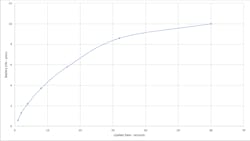How to balance wireless sensor update rate and battery life
Though the majority of instrument and controls engineers have an electrical background (confirmed by the surprise people still have when I tell them I was trained as a chemical engineer and, like them, “fell” into this profession), we all need to remember that the reason we are installing all our sensors, control elements and control systems is to control and manage the process. The point of this message is that process dynamics need to be part of the design process.
With wired devices that are not power-constrained, the update rate is decided by the I/O card and controller. Battery-powered wireless devices, however, do need to manage their energy consumption, and the most common way of doing so is by configuration settings of the update rate.
Though update rates for wireless sensor networks (WSN), WirelessHART and ISA100.11a can be as short as 0.5 sec., as the update frequency is increased, there is an associated exponential decrease in battery life. As expected, the largest impact is at the faster update rates that might be required for closed-loop control. Longer update periods (beyond 60 sec.) are constrained by basic battery life physics (see figure) more than the update rate, thus setting the limit on the slower-update-rate side of the equations.
So how to balance the update rate and battery life?
Basic control theory recommends that the update rate of the measurement shall be a minimum of three times faster than the process time constant. I personally prefer an update rate of six times the process time constant, if possible, because then I am sure to observe all stages of an oscillatory process. However, using the three-times-faster basis for a temperature loop (where measured temperature changes with a sensor inside a thermowell can be 16 sec. or longer, given how much time is required for heat to penetrate the thermowell and its mass), the required wireless update rate would be roughly 5 sec. Since WSN cycles increase by doubling each time, the closest approximation for this loop is a 4-sec. update rate.
Industry practice and experience also recommend the update rate should be four to 10 times faster than the time constant of the process for regulatory closed-loop control, so though it’s at the low end, the 4 sec. update rate would also work in this example.
Another, non-process-related consideration in addition to battery life is the impact traffic may have on the network itself, and in particular, the access point or gateway. One WSN manufacturer recommends keeping update rates no faster than 4 sec. since doing so can impact the total number of wireless devices that can be put on a gateway. Therefore, the 4 sec. update rate for this example works well by meeting all three minimum criteria.
Temperature is one example of a slow process. Level measurement, especially in large tanks, is another. These sorts of measurements are well suited to wireless sensing because they can operate with slower update rates, and when you consider that large tanks and tank farms are widely distributed, not having to install cable infrastructure makes a lot of sense.
With today’s computing power, the smart people working in our industry have developed a number of fancy tricks to compensate for the effects of delayed measurements, such as custom P&ID algorithms for wireless networks that consider lag, other control algorithms (such as Smith Predictors, developed in 1957), or other math. (Some would say mask rather than compensate, especially if they are used improperly by a person not understanding and applying first principles correctly.)
Despite all the advances we have made and continue to make with our control systems, it is always good to remember why we are implementing the application, as well as the underlying associated engineering principles, and basic laws of physics and chemistry that need to be followed.
Not everyone makes a good controls engineer, technician or practitioner, however, if you remember the basic laws of physics and chemistry, the chances of succeeding going up significantly.
About the Author

Ian Verhappen
Ian Verhappen

Leaders relevant to this article:


